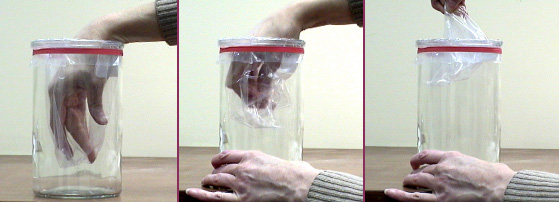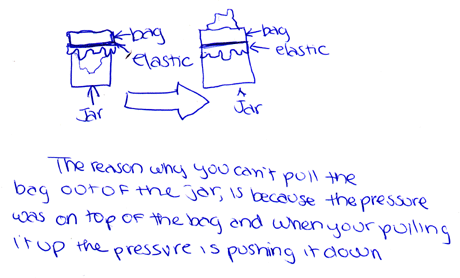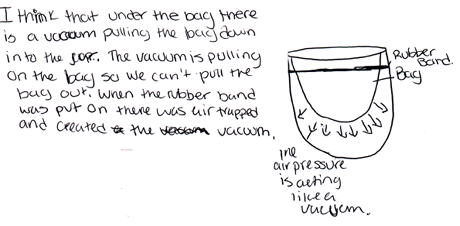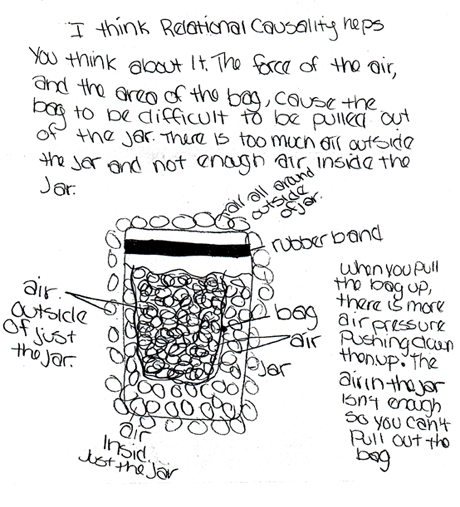Air Pressure Curriculum
Section 3—Lesson 5: Contrasting Linear and Relational Causality in Explaining Air Pressure Phenomena
Lesson Plan
Materials
- Jar, wide-mouthed, 1 per pair of students
- Plastic sandwich bags, 2 per pair of students
- Thick rubber band, 1 per pair of students
- Modeling the Jar and the Bag activity sheet, 1 per student (PDF 14 KB)
- Thinking About Relational Causality sheet, 1 per student (PDF 16 KB)
Prep Step
- Review the lesson plan, background information, and understanding goals.
- Photocopy the activity sheet, Modeling the Jar and the Bag.
- Assemble a set-up of the jar, plastic bag, and rubber band before class.
- Photocopy the sheet, Thinking About Relational Causality.
- Read the Picture of Practice.
Analyze Thinking
Step 1: Exploring a Pressure-Related Phenomenon that Involves Relationality
Introduce a simple problem involving relational causality that many students already think that they know the explanation for.
- Show students a garbage bag inflated with air.
- Have them take turns trying to push their fist into the garbage bag. Are they able to? Why or why not?
- Ask, "What do you think is going on?"
Students may realize that there is air in the bag and may say that the air takes up space. Explain that the activity that they do next will help them think about what is happening with the inflated garbage bag in a more complex way.
RECAST Thinking
Step 2: Modeling the Jar and the Bag Activity
Have students work in pairs to do the Modeling the Jar and the Bag activity. The activity provides students with an opportunity to consider relational causality. In the activity students:
- Construct a model to explain what prevents a bag sealed to the outside rim of a jar from entering the jar.
- Construct a model to explain what prevents a bag that is placed into a jar and then sealed to the outside rim of the jar from being pulled out of the jar.
- Consider the relationship between the air inside the jar and outside the jar.
- Complete the questions that go along with the activity.
Note to Teacher: As students are doing the activity, make sure they have the bag sealed securely with a thick rubber band in order to feel how difficult it is to pull the bag out of the jar or push the bag into the jar.
As students finish up the activity, encourage them to think about how air pressure played a role in preventing them from pulling the bag out of the jar and pushing the bag into the jar.
| Demonstration of Pulling the Bag Out of the Jar |
 |
Explore Causality
Step 3: Sharing, Discussing, and Critiquing Students' Models for Explaining the Jar and the Bag Activity
Have students share their models. Explain the guidelines for discussing models before you begin.
- All ideas are valued.
- When your model is critiqued, it is not intended to be personal. Rather, models are critiqued for the learning benefit of the class as a whole.
- The critique must begin with positive feedback. The class should discuss what is helpful about each model.
- After positive feedback, provide constructive criticism. Constructive criticism focuses on what would make the model work better. The class should discuss what the model is missing and what might limit someone's understanding of it.
Tell the class that scientists critique, change, and discard models frequently. This is how they share their findings with each other, learn from one another, and push their scientific understanding forward.
Invite students to draw their models from the activity, Modeling the Jar and the Bag, on the board. Include students who had both linear and relational models.
| Examples of Students' Models | ||
|
||
|
||
|
Note to Teacher: Some students might say it happens "because of a vacuum." Substituting a label for an explanation is a kind of token explanation that can signal shallow understanding. When students use token explanations, push them to explain what they mean by the words they use. Ask: "What do you mean by a 'vacuum?' What is going on?" Ask them to explain their answers at a deeper level. Most will not know how to conceptualize a vacuum beyond thinking about it as an entity. Once they are able to consider a relationship as the cause of what happens, they should begin to understand that what is going on is a process, not a "thing."
In the next lesson, students will learn about Boyle's Law which helps to explain what is going on. As you pull the bag out of the jar, you lower the air pressure in the jar and create a differential with higher pressure outside the jar than in it.
Step 3: Discuss the Models in Terms of Causality
Discuss the students' models, and how some reflect a linear causality while others reflect a different form of causality.
- Ask, "Do you see some models that have a linear form, where one thing makes another thing happen? For instance, a vacuum makes something happen, or the air outside the jar makes something happen?"
- Encourage students to notice linear aspects of their models. If they have difficulty, point out the aspects that you see and explain what makes them linear.
- Ask, "Do you see some models that do not have a linear form, where there is a relationship between two or more variables that contributes to the outcome?"
- Encourage students to see that some of their models involve a relationship between inside and outside air pressure. If none of the models have this aspect, draw and explain one.
Note to Teacher: Be sure not to shortchange this discussion. It offers an important basis for the rest of the section.
Step 4: Introduce Relational Causality
- Hand out the sheet, Thinking About Relational Causality, to read and discuss.
- Ask: "Does this help you to think about what is going on in any way?"
- Discuss students' ideas.
Make sure that students see relational causality as more than just two contributing causes (in an additive sense). The crucial piece is that you have two variables in relation to each other (higher/lower, more/less, etc.) that contribute to the outcome. You should be able to compare the values of the two variables.
Review, Extend, Apply
Step 5: Revisit Students' Models in Terms of Linear and Relational Causality
Help students apply what they have learned about relational causality to the activity that they just completed. Ask:
- "In what ways does a linear causal model fail to explain what happens in the jar and bag activity?" (It doesn't account for the air pressure that is both inside and outside the jar, and the relationship between them.)
- "Do you think the jar and bag activity is a good example of a relational causal model? Why or why not?"
- "Is relational causality involved in the garbage bag problem presented at the beginning of class?"
- "What are some other relational causal stories that you can think of?"





